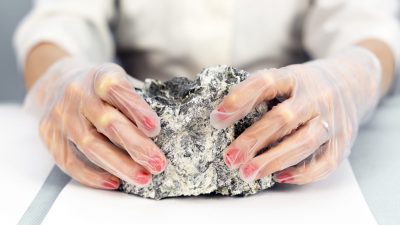Asbestos Cement Siding Inspection
by Nick Gromicko, CMI®
Asbestos cement is a composite material made from Portland cement reinforced with asbestos fibers. Manufacturers popularized asbestos cement siding before banning it in the U.S. in the 1970s. During inspections, InterNACHI inspectors often encounter this type of exterior cladding. Both inspectors and homeowners benefit from understanding the health risks associated with asbestos cement siding, as well as common problems related to its damage and deterioration.
History
In 1907, Austrian engineer Ludwig Hatschek developed a method to shape asbestos cement into sheets, which allowed its use as siding and shingles. By the 1920s, the National Board of Fire Underwriters recommended asbestos cement over wood for siding and roofing due to its superior fire resistance. This endorsement led to a surge in popularity, and by the 1940s, many U.S. homes featured asbestos cement siding.
However, reports in the late 1960s and early ’70s highlighted the health hazards of asbestos. As concern grew, the federal government responded, and in 1973, the EPA banned asbestos in building products.
Health Risks Associated with Asbestos Cement
Inhaled asbestos fibers pose serious health risks. Asbestos dust can cause asbestosis, a type of lung cancer, and mesothelioma, a deadly cancer affecting internal organs. Asbestos cement siding, when properly installed and undisturbed, does not pose health risks. The cement binds the asbestos fibers, preventing their release into the air under normal conditions.
The EPA considers asbestos hazardous when it becomes friable, meaning it can crumble or pulverize by hand. Friable asbestos releases airborne particles that can cause health issues. Siding remains safe as long as it is not disturbed or damaged in ways that release asbestos fibers.
Advantages
- Asbestos cement siding resists fire, unlike vinyl and wood.
- It withstands termite damage and rotting.
- The siding can mimic other materials, such as wood grain.
- It is easy to clean and maintain.
- Unlike wood, asbestos cement siding doesn’t absorb paint quickly, making repainting easier.
Disadvantages
- The material is brittle and prone to chipping, cracking, or breaking.
- High-pressure washing can crack the siding and lead to moisture issues.
- Pulverizing asbestos cement through activities like sawing or sanding can release dangerous fibers.
- Finding replacement siding for repairs is challenging.
- Asbestos cement siding cannot be refurbished like wood clapboard or cedar shake siding.
- It is no longer considered aesthetically desirable.
Maintenance
Proper maintenance of asbestos cement siding is crucial to prevent structural and health issues. Keeping the siding clean and repairing damage promptly is essential. Brittle siding can crack, chip, or suffer from impact damage, potentially releasing asbestos particles. Replace irreparable damaged sections with non-asbestos fiber cement that mimics the appearance of the original material.
Incorporate landscaping features, such as shrubs, to protect the siding from impact damage.
Inspection Tips
Inspectors frequently encounter these issues with asbestos cement siding:
- Chipping and cracking due to its brittleness.
- Fasteners deteriorating faster than the siding.
- Discoloration or staining from corrosion or runoff, which might indicate decreased durability.
- Efflorescence, a crystalline growth from water passing through the material, indicating potential deterioration.
- Biological growth, like moss and algae, which can stimulate surface damage and staining.
As asbestos cement siding was a popular choice for many years, inspectors often find it during exterior inspections. Understanding the associated health risks helps answer client questions, although specific concerns should be directed to a healthcare professional. Homeowners should schedule regular inspections with an InterNACHI inspector as part of their home maintenance routine.




